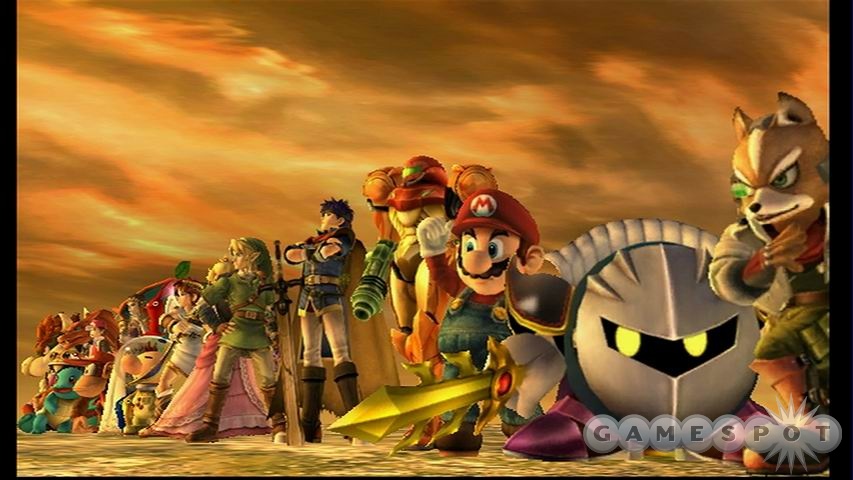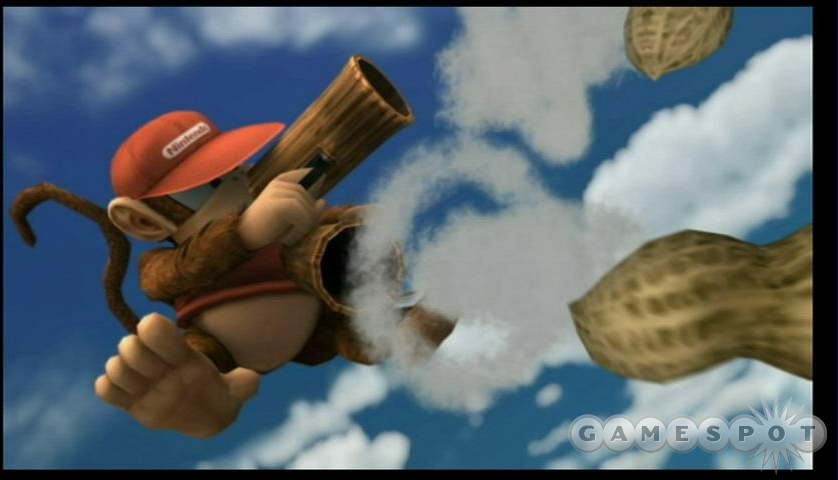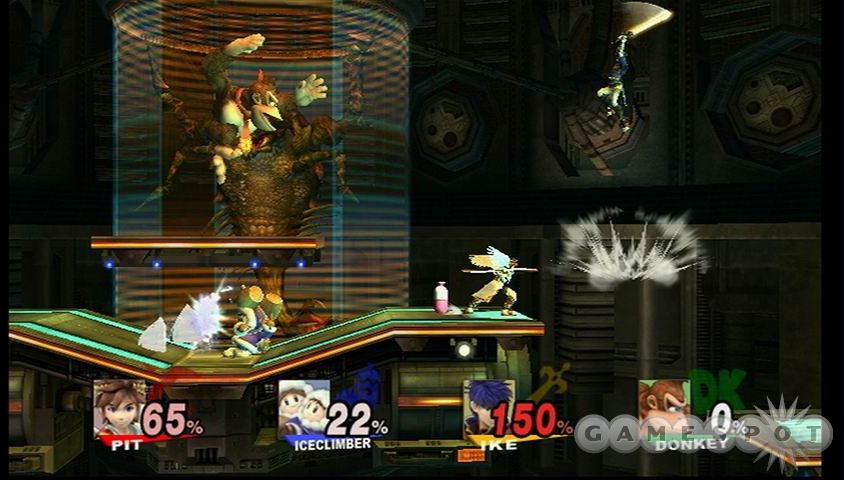It's hard to believe, but it's been nine years since the original Super Smash Bros. brought some of the most iconic Nintendo characters together for frantic battles, and roughly seven years since its sequel Super Smash Bros. Melee was released. Perhaps even harder still to believe--and a testament to the series' popularity and longevity--is that these games are still being played religiously to this day. But no matter whether you're a diehard Smash Bros. fanatic or a neophyte brawler, you'll be pleased to know that Super Smash Bros. Brawl includes a plethora of impressive characters, features, and game modes, and is more accessible and fun than ever before.
For the uninitiated, Smash Bros. is a multiplayer-centric series of fast-paced 2D fighting games that features a cast of characters from all over the Nintendo universe. If you've ever found yourself arguing with a friend about whether or not Mario could beat Link in a one-on-one match, Brawl is the game that will let you settle the issue once and for all (the answer of course is that Kirby would eat them both). Characters such as Ike from Fire Emblem, Meta Knight from Kirby, Fox McCloud from Star Fox, Lucas from the unreleased-in-the-US Mother 3 (Earthbound 2), Pikachu from Pokémon, and many more are all on the roster in Brawl, boosting its size up to an impressive 35 total characters--14 of which are hidden and must be unlocked. For the first time, the list of guests includes third-party, non-Nintendo characters such as Solid Snake and Sonic the Hedgehog, and all of them bring their own signature fighting styles and moves to the game.

Smash Bros. has always been one of the most accessible fighting games on the market because of the simplicity of its controls, and Brawl is no different. There are essentially only two attack buttons (one for normal attacks and one for special moves), and depending on which way you tilt your control stick when you hit them, they can produce a variety of effects that include the titular "smash" attacks. In the interests of user friendliness, Brawl offers four possible control schemes, which ensures that everyone can play whichever way they like; Wii Remote and Nunchuck, Wii Remote alone, Classic Controller, and GameCube Controller are all equally represented. Each of these methods are equally viable, and fans of Brawl's predecessor will be happy to know that the GameCube controls remain unchanged.
Combat includes up to four players brawling on video game-themed stages. The goal is to knock your enemies out of the arena with one of the aforementioned smash attacks. The amount of damage each character has sustained is measured in a percentage, and the higher this percentage is, the farther he or she flies when hit. Battles are fast-paced, frenetic, fun, and often outrageous orgies of chaos, which makes Brawl a perfect party game. But just because the game's mechanics are so simplified compared to traditional fighters doesn't mean that there isn't a lot of depth to be found for those willing to invest the time.
All of the characters have their own strengths and weaknesses, and learning how to protect yourself while taking advantage of your opponents' flaws goes a long way toward securing a victory. There can be a surprising amount of strategy involved, from knowing when and how to attack to ensuring that the terrain of the sometimes over-the-top levels works for you rather than against you. But all that said, Brawl is an incredibly well-balanced game in which even a brand-new player can come away the victor against a hardened veteran.
Throughout combat, various types of items will spawn on the battlefield for use by the first player to reach them. Some, such as the beam sword, are offensive in nature and augment your attack capabilities, whereas others are restorative and will lower your damage meter. Many of these items are from the various games the characters originate from, such as the fire flower and the super mushroom from Super Mario Bros. Although a lot of them have been featured in the previous Smash Bros. games, many new ones appear in Brawl, including the superspicy curry, which makes your character breathe fire for a time. Also worthy of a mention are the various assist trophies, which summon non-playable characters such as Tingle from The Legend of Zelda: The Wind Waker or the 8-bit racers from Excitebike to help or hinder you. Some things--especially the hammer, bob-omb, and warp star--could be considered game-breaking due to their abilities to inflict fatal wounds nearly all of the time, but these items and any others can be toggled off in the options menu before a match begins.
In fact, customizable is the name of the game, given that a wide variety of parameters can be adjusted when participating in the special brawl mode. Gravity, fighter size, and game speed are just a few of the options, with some of the more outlandish possibilities being whether or not your characters are made of metal (which makes them much heavier and thus harder to KO) or are virtually invisible. Both special brawl matches and regular battles let you customize which items are allowed and how often items will spawn, what kinds of handicaps--if any--are in place, how stages are selected, and more.
Teams can be created if you so desire, and the types of brawls that can be started include timed matches in which the one who scores the most kills and the least deaths wins, stock matches in which the last player standing wins, and coin-collecting matches in which the number of coins everyone has when time is up determines the winner. Tournaments are a snap to set up due to a built-in mode that facilitates up to 32 players on a single Wii, and there's even a rotation mode to help up to 16 players figure out how to take turns. In short, there are literally dozens of ways that you can battle in your living room.
However, that's not to say that all your matches have to be held in your home with your friends at hand. For the first time in the series, Brawl lets you play matches online. If you're interested only in a quick match, you can join a standard or team-based game with anyone and the game will attempt to find you three competitors. Each person will select his or her character and stage of preference, and while you're waiting you'll be tossed into a practice room alone to warm up. Once everyone's settled, one of the requested stages will be chosen at random and the brawl will get underway.
For more control over your matches, you'll have to connect to friends via the dreaded friend codes. Despite their annoyance, friend codes unlock a lot of otherwise unavailable options. Friend matches let you customize an online match the same way you would a local one, and they even open up a couple more game types. As an added bonus, you'll be able to add in extra local players, which isn't the case when playing with strangers. Lag has always been an issue with online games--and especially fighters--but of all the battles we participated in, only one of them suffered from any major lag, and most of them ran so smoothly that we wouldn't be able to tell that it was an online match if we didn't already know.

Competitive battles and cooperative missions aren't the only things to do with your friends in Brawl. Whenever you finish a multiplayer match that lasted less than three minutes, you can save a full replay of the battle for playback later, and at almost any time in the game or during these replays, you can pause and position your camera to take the perfect screenshot. Then, using the WiiConnect24 service, you can send these replays and screenshots to anyone on your friends list to show off.
Even though Brawl includes a multitude of fun and unique battlefields in which your matches can take place, in the event that you find yourself wanting more, it also offers a custom stage-editor tool so you can make your own from scratch. Using a simple interface, you can specify a size, background picture, and theme song to go along with your masterpiece. Then it's just a matter of selecting which of the premade terrain parts and platforms you want to lay out, and afterward you save the level. This tool works surprisingly well, and though your creations unfortunately can't be used in online matches, you can share them with your friends via WiiConnect24 just as you would a screenshot.
Though Brawl is primarily a multiplayer game, that doesn't mean it isn't without single-player challenges. Classic mode runs your character of choice through a variety of sequential battles as well as two bonus stages before pitting you against the sinister Master Hand, the mysterious disembodied hand that has appeared in every previous game in the series. Each time you play through classic mode, the rounds will change subtly, so you'll never go through the same version twice. Event mode is a series of individual challenges that force you to complete specific objectives to win. Training mode lets you hone your smash skills against opponents whose behaviors you can customize. In stadium mode, you can race against the clock to destroy targets in an obstacle course, try to score a distance record in a home-run contest, or face off against an army of enemies in the multiman brawl.
However, the main attraction in single-player is the adventure mode known as the subspace emissary. This is a retooled version of the adventure mode from Super Smash Bros. Melee that features a single story in which all of the characters in the game join together in an epic battle against a mysterious enemy. Subspace emissary follows the exploits of the various characters as they interact with each other, and is typically divided up into a number of loose story threads that eventually weave together; in one level, you may play as Donkey Kong and Diddy Kong, and in the next you may be Lucas and the Pokémon Trainer. Between each level, you're treated with very high-quality and frequently hilarious cutscenes that further advance the story (and in typical Nintendo style, they are entirely dialogue-free).
The subspace emissary consists almost entirely of side-scrolling platforming levels that are filled with the usual bottomless pits, moving platforms, and enemies, and each one is designed to resemble some of the games that the characters are from. For instance, Donkey Kong's early levels are reminiscent of Donkey Kong Country, launcher barrels and all. These platforming levels are for the most part well designed and fun to play, but there are some--in particular the automatically scrolling ones--that the game could have done without, and there are some characters that just don't seem to handle platforming as well as others. Overall, though, the Subspace Emissary is an entertaining new experience for Smash Bros. and a full game in its own right, given that it will last you between eight and 10 hours. To sweeten the deal even more, Subspace Emissary, and in fact all of the single-player game types with the exception of the training and classic modes, can also be played with a friend cooperatively.

Super Smash Bros. Brawl is easily one of the most impressive-looking games on the Nintendo Wii, and even when four players are battling each other onscreen at once in the largest levels, the frame rate never drops once. All of the characters look stunning in their new designs, and their every action, from their taunts to the expressions they make when on the receiving end of a blow, is exceptionally well animated. Equally impressive is the game's soundtrack, which boasts more than 100 songs from all over the Nintendo universe and beyond. Each of these tracks is arranged specifically for Brawl by a star-studded lineup of composers that includes notables Koji Kondo (Super Mario Bros.), Yasunori Mitsuda (Chrono Trigger), Yoko Shimomura (Kingdom Hearts), and more.
Every now and then, a game comes along that is entirely must-have for every owner of the platforms it is released on. Last holiday season, Nintendo struck that kind of chord with Super Mario Galaxy, and now, less than six months later, that feat has been repeated with Super Smash Bros. Brawl. Its simple controls and gameplay make it remarkably accessible to beginners yet still appealing to Smash Bros. veterans. With the inclusion of mostly lag-free online play and the ability to share screenshots, custom levels, and game replays with friends, it offers an unparalleled multiplayer experience previously unseen on the Wii. Mix in all of the unlockable characters and stages, the lengthy single-player adventure, and the exorbitant number of collectible trophies and stickers to find, and you've got yourself the recipe for a game that, if its predecessors are any indication, people will be playing for years to come.




